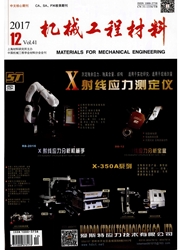

 中文摘要:
中文摘要:
在电流密度分别为1.7,50mA·cm^-2下电镀制备了两种电镀铜基板,将其与锡粒回流焊接成锡/铜接头,并在150℃老化不同时间(10,20d),观察了电镀铜基板表面和锡/铜接头界面的形貌,分析了柯肯达尔空洞在老化过程中的演变机制。结果表明:经老化处理后,两种锡/铜接头均在Cu3Sn/Cu界面形成空洞,空洞的密度随着老化时间的延长逐渐增大,高电流密度下的空洞密度也大;使用较高电流密度制备电镀铜基板的接头,未经老化处理其界面已出现空洞,经老化处理后,空洞逐渐聚集成为空腔,空腔内表面成为铜元素的快速扩散通道;电流密度会影响表面电镀层的组织结构,从而影响后续老化过程中界面的组织结构。
 英文摘要:
英文摘要:
Two electroplated Cu substrates were prepared at current densities of 1.7 mA·cm^-2 and 50 mA·cm^-2. Then by reflow soldering the electroplated Cu substrates and Sn granular, the Sn/Cu joints were obtained and aged at 150 ℃ for different times (10, 20 d). The surface morphology of the electroplated Cu substrates and interface morphology of the Sn/Cu joints were observed and the evolution mechanism of Kirkendall voids during aging was also analyzed. The results show that after the aging treatment, the voids were formed at Cu3Sn/Cu interface of the two Sn/Cu joints and the density of voids increased gradually with the expansion of aging time and was relatively high at a relatively high current density. Before aging treatment, the voids appeared at the interface of the joint with the electroplated Cu substrate prepared at a relatively high current density; after aging treatment, the voids aggregated gradually and then changed into cavities. The inner surface of cavities became the channels for the rapid diffusion of Cu. The microstructure of the surface electroplate layer was influenced by the current density, which in turn influenced the interfacial microstructure in the following aging process.
 同期刊论文项目
同期刊论文项目
 同项目期刊论文
同项目期刊论文
 Finite element simulation of butt welded 2.25Cr-1.6W steel pipe incorporating bainite phase transfor
Finite element simulation of butt welded 2.25Cr-1.6W steel pipe incorporating bainite phase transfor Phase stability, magnetism, elastic properties and hardness of binary iron nitrides from first princ
Phase stability, magnetism, elastic properties and hardness of binary iron nitrides from first princ Effects of additive elements on structural and electronic properties of Sn-based intermetallics by f
Effects of additive elements on structural and electronic properties of Sn-based intermetallics by f 期刊信息
期刊信息
